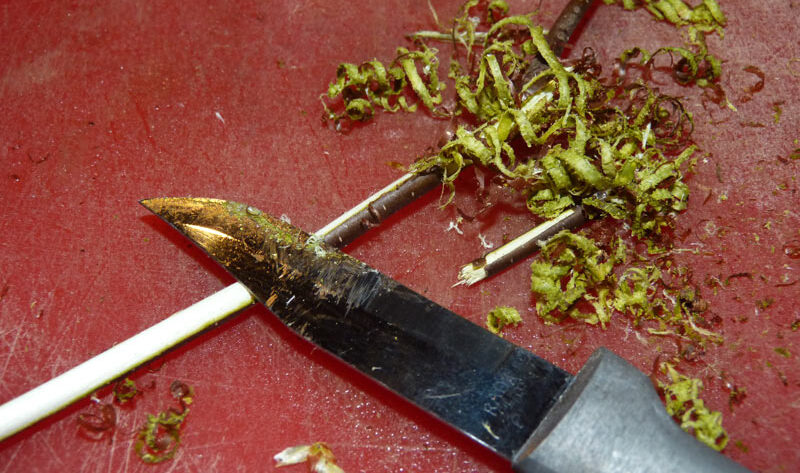Black Birch (Betula lenta) is one of my all-time favorite trees. In the forest where I grew up, I we had thousands of black birch trees. Any time there was a thicket (or if someone would cut a part of the forest down), the birch trees would quickly spring up and grow thickly. This is exactly why the ancient Celts began the Ogham with Birch (beith), and why birch is considered a tree of new beginnings–they are the first to spring up and heal the forest.
On smaller trees, the black birch has a lovely black bark with little white flecks. When you break off a branch, it has a medium green inner bark that smells–and tastes–of wintergreen. This birch bark has wonderful properties, both magical and medicinal. The inner bark has methyl salicyclate, which is used primarily today for muscle pain (note that muscle rubs like Ben Gay have about 30% methyl salicyclate in its ingredient list!); black birch tea is also good for colds, soreness, and cleansing of the body. Magically, birch is connected to the element of water, and is a tree of renewal, rebirth, regeneration, protection and cleansing. Its also very good for calming the emotions.
I brought the black birch back with me from a recent visit to the forest to which I belong in PA to make two other recipes- a black birch tincture and birch water. But when I recently saw Jim McDonald, a fabulous herbalist, for a consultation and I mentioned to him that I had collected a number of budding birch branches, he gave me this recipe and it is turning out amazingly awesome, so I wanted to share it.
Black Birch Sore Muscle Rub / Massage Oil
For both of the recipes, you want to use small twigs or budding branches from the black birch tree. Late winter and spring is the best time to collect because the sap is running then and the tree is renewing itself after a long slumber.
Here are my branches–I added about 1 cup of oil, and I used about 2/3 of what you see here to make the oil.

Get 1 cup or so of neutral oil as your base. I wanted something that had some good shelf life, so I purchased sesame oil. Almond oil would work too, but it has a shorter shelf life. Olive oil has its own unique scent, so I’m not sure how it would work.

The goal is to get as much of the inner bark, finely chopped and exposed, into your oil. To do this, I cut up the smallest branches with scissors to get them into 1/2″ or so pieces and then used my mortar and pestle to expose the inner bark and smash them up a bit. On the larger branches, I took a good sharp knife and simply scraped the bark off. Both methods worked very well!


I filled up a mason jar with the birch bark scrapings and small branches until they reached the top of the oil.

I sealed it up and I’m letting it sit for three weeks (minimum) but not more than 5 or so weeks (I let mine sit too long, like 9 weeks, and it went bad and I had to get a new batch started). After only a few days, the oil is already beginning to take on the scent of the black birch–I can’t wait till it is complete! After the time has passed, I will strain it and jar it up and use it for back-rubs, massages, sore muscles and the like :). My second batch, after straining, worked soooo well! I’m adding a little coconut oil and it will be a wonderful sore muscle rub.

Black Birch Tincture
The process for making the tincture is actually quite similar; the only difference is that instead of using a neutral oil, like sesame, you use grain alcohol. Everclear or vodka can be used. Even after a day, you’ll be able to taste and smell the tincture; the tincture goes to this lovely green color (similar to the inner bark) and smells just awesome. Give it a month or so, and you will have an amazing tincture!




Could you do this in alcohol as an astringent?
Yeah, that’s pretty much what the tincture is. It has great astringent properties — my grandmother also used to use it as a “facial toner” (that was with birch water, where you boil water then pour it over branches and let it sit overnight).
We have black birch here in MI dont we, oh never mind I’ll google it 😉 lol
Some great ideas here. I’ve long been a devotee of birch essential oil, but this will be at least equally good. By the way, you will find that birch pairs well with olive oil if you want to use it.
Olive oil has a little stronger of a smell, that’s why I went with sesame. Thanks for the hint! 🙂
Do you live in an area where there are Black Birch Trees or where did you source the Black Birch Branches you used? I used to live in North Carolina, but now live in Florida. I have been trying to find a source where I can purchase fresh Black Birch branches. If you know of a source, I would appreciate any information you could share.
Hi Victoria, I harvest them myself. There doesn’t seem to be a good source for them online. The best time to harvest is in the early spring once the sap starts flowing (Feb – April). I might be up for a trade for something from flordia–do you have access to passionflower? :).